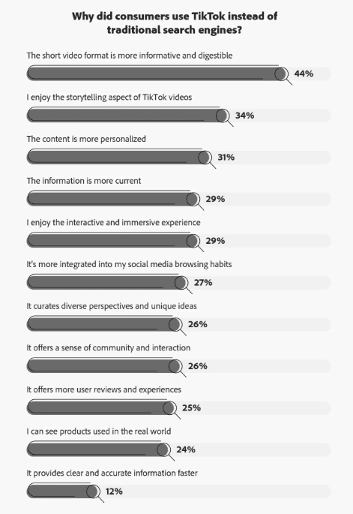More Than Just Dance Challenges
Just a few years ago, TikTok was mainly associated with viral trends and dances. Today, it’s a dynamic tool that combines entertainment with search and shopping. More and more young people see TikTok less as a social platform and more as their main source for inspiration, reviews, and product research.
TikTok is becoming the search engine of a new generation, and TikTok Search Ads respond directly to this major shift in digital behavior.
Why does Gen Z search on TikTok instead of Google?
Gen Z and young millennials often no longer want to dig through long blog articles or outdated reviews. They want instant video answers ideally from someone who looks like them and speaks their language.
In recent years, there’s been a clear trend of Gen Z migrating from Google to TikTok as a source for discovery and inspiration.
45% of Gen Z prefers social media (TikTok, Instagram) as their primary way for finding information (compared to around 24% of the general population). source
62% of Gen Z uses TikTok for local searches (e.g., restaurants), 67% uses Instagram, and only third place comes Google (61%). source
Instagram 30,4%,
TikTok 23,2%,
Google 18,8% source
Around 10% of Gen Z chooses TikTok over Google as their main platform for information search. source
An Adobe study helps explain why TikTok attracts users: it’s mainly thanks to short, light video content, unique storytelling, and personalized content.
 Source: 2024 Adobe survey
Source: 2024 Adobe survey
What are TikTok Search Ads and how do they work?
TikTok Search Ads meet this demand by placing sponsored content directly in search results, exactly where the user is looking for specific topics, products, or inspiration.
Where do TikTok Search Ads appear?
Search Results Page – Ads appear among results when users search keywords (e.g., “dinner idea”) and are marked as sponsored. Currently available to audiences in the US, Canada, and Japan, but new locations are added regularly.
How does TikTok Search Ads targeting work?
Based on keywords
Based on behavioral data (user activity and interests)
Ability to add exclusions (negative keywords)
Ad Formats on TikTok
Feature | TikTok Search Ads | In-Feed Ads | Top View Ads |
User intent | High (actively searching) | Medium / low (scrolling) | Awareness (high visibility) |
Cost | Low to moderate CPC | Variable (often higher) | High (premium format) |
CTA | Clickability, drive-to-site | Engagement / branding | Branding |
Advertising potential: when is it worth testing TikTok Search Ads?
TikTok Search Ads work best when users are:
solving a specific problem
looking quick answers/recommendations
comparing products
Industry examples:
Beauty, e.g., “best foundation for summer,” “how to cover redness”
Fashion - “wedding guest outfit,” “outfit for thesis defense”
Food & Beverage - “healthy lunch for work”
Travel - “where to go for the May holiday,” “what to pack for a flight”
E-commerce - “is it worth buying X?”, “smartwatch review”
Education - “how to pass an oral exam,” “language learning tricks”
Advantages of TikTok Search Ads:
Intent-based clicks = better CTR and conversions
Potentially lower CPC than Top View or Boosted Posts
Great addition to an always-on strategy
When are TikTok Search Ads NOT the Right Fit?
When the goal is broad reach (e.g., brand launch), In-Feed or Top View formats work better.
When the product does not address a specific need or user question.
If your product has a long consideration phase.
5 things you need to know before launching Search Ads on TikTok
1. Keyword selection
Don’t reuse Google Ads keywords. Focus on how users speak on TikTok (emotional, casual, and concise).
Useful tools:
TikTok Keyword Insights
Search term report in Ads Manager
Comments under viral videos
2. Creative – match the format to intent
Match the tone. The ad should feel native and blend with organic content. Video with emotion, real results, text on screen.
3. Hooks and the first seconds
Grab the user’s attention from the first seconds:
“See what happened after 7 days…”
“Don’t buy this cream before you see this”
4. Performance analysis
CTR: Benchmark against In-Feed or organic performance.
Conversions: track UTM and events via TikTok Pixel.
Collect queries from the search engine.
5. Search Ads + In-Feed = synergy effect
The user sees the brand in the feed and then searches for it – Search Ads help close the loop by capturing users ready to convert.
What’s next? How to approach testing Search Ads?
TikTok Search Ads is a growing channel with strong potential if approached strategically.
Here are some key rules to keep in mind:
Start with a small test budget - don’t invest large sums right away. First, check which keywords and creatives deliver the best results.
Choose phrases precisely - use the language and words your target group actually uses on TikTok, based on trend analysis and popular queries.
Optimize campaigns – monitor results in real time and remove weak keywords or creatives that don’t bring conversions.
Integrate Search Ads with other formats – Search Ads perfectly complement In-Feed or Top View campaigns, building an effective sales funnel.
Treat tests as a “test & learn” process – TikTok is evolving fast, so stay flexible and ready to adapt.
Strong preparation matters. With solid analysis, planning, and quick reactions, you’ll stay ahead of the curve. This is still a new channel, few people know it, so fast adaptation = competitive advantage!
Ready to test? Here’s what to keep in mind before launching. 👇
Download the starter guide with:
The most common mistakes when launching TikTok Search Ads + tips on how to avoid them
A keyword map
A toolkit for building your keyword list
A checklist for creatives and optimization
KPI suggestions






